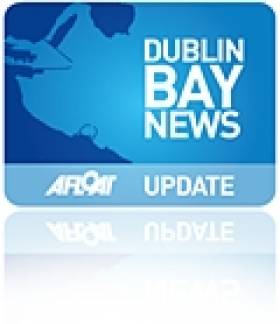Displaying items by tag: deck lights
Jack up Barge Arrives on Dublin Bay
These jack-up barges will be used for the drilling of test boreholes at various locations within Dublin Bay and its approaches. Initially, the "Aran 250" will be used and it is expected that under normal conditions it will operate on a 24 hour / 7 day week basis.
At all times when the jack-up barge is on location it will transmit an "AIS" signal. By night the barge will display white lights (operated in unison) flashing Morse code (U) every 15 seconds. These will be located at each corner. The barge itself will be lit by operational deck lights.
When the jack-up barge is operational it will have the standby boat "James Joyce" with two people on board in attendance. They will tie-up to a buoy moored approximately 300 metres away from the barge. The small tug "Trojan" will operate as a supply boat and will be based at the Poolbeg Marina. The Trojan will also be used for towing the barge from one location to the next.
The test borehole drilling positions (WGS 84) are as follows :-
M06 Lat 53˚ 19' 53.46'' N Long 006˚ 09' 39.08'' W M15 Lat 53˚ 19' 11.35'' N Long 006˚ 06' 58.16'' W
M07 Lat 53˚ 19' 11.27'' N Long 006˚ 08' 21.42'' W M16 Lat 53˚ 18' 32.75'' N Long 006˚ 06' 33.07'' W
M08 Lat 53˚ 19' 50.64'' N Long 006˚ 06' 21.73'' W M17 Lat 53˚ 20' 23.37'' N Long 006˚ 05' 16.93'' W
M09 Lat 53˚ 18' 38.17'' N Long 006˚ 05' 45.02'' W M18 Lat 53˚ 19' 32.50'' N Long 006˚ 05' 19.69'' W
M10 Lat 53˚ 17' 44.38'' N Long 006˚ 03' 41.33'' W M19 Lat 53˚ 18' 16.91'' N Long 006˚ 05' 02.71'' W
M11 Lat 53˚ 19' 42.31'' N Long 006˚ 03' 22.31'' W M20 Lat 53˚ 17' 51.94'' N Long 006˚ 04' 43.04'' W
M12 Lat 53˚ 19' 00.03'' N Long 006˚ 00' 25.74'' W M21 Lat 53˚ 18' 56.68'' N Long 006˚ 04' 07.12'' W
M13 Lat 53˚ 19' 51.50'' N Long 006˚ 10' 13.42'' W M22 Lat 53˚ 19' 09.75'' N Long 006˚ 02' 37.54'' W
M14 Lat 53˚ 19' 59.29'' N Long 006˚ 07' 53.39'' W M23 Lat 53˚ 18' 48.98'' N Long 005˚ 59' 07.97'' W
Each location will take approximately 1 week to drill. Drilling will not follow in sequence listed above. VTS will keep all shipping advised with regards to the location at which the barge is operating.
More detail is contained in a marine notice issued by Dublin Port Company's
Harbour Master, Captain David T. Dignam HERE





























































